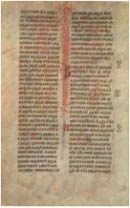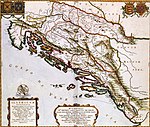This is an old revision of this page, as edited by Wüstenfuchs (talk | contribs) at 17:57, 17 March 2011 (→Controversies and polemic). The present address (URL) is a permanent link to this revision, which may differ significantly from the current revision.
Revision as of 17:57, 17 March 2011 by Wüstenfuchs (talk | contribs) (→Controversies and polemic)(diff) ← Previous revision | Latest revision (diff) | Newer revision → (diff)| Croatian Cyrillic Bosančica | |
|---|---|
 A miniature from the Hval Manuscript A miniature from the Hval Manuscript | |
| Script type | Alphabet Cyrillic script |
| Time period | 10th-18th century |
| Languages | Bosnia and Croatia (Dalmatia and Dubrovnik regions) |
| This article contains phonetic transcriptions in the International Phonetic Alphabet (IPA). For an introductory guide on IPA symbols, see Help:IPA. For the distinction between , / / and ⟨ ⟩, see IPA § Brackets and transcription delimiters. | |
| Part of a series on the |
|---|
| History of Bosnia and Herzegovina |
 |
Early history
|
Middle Ages
|
Ottoman era
|
| Habsburg era |
| Yugoslavia |
Contemporary
|
|
|
| Part of a series on the |
|---|
| History of Croatia |
 |
| Early history |
| Middle Ages |
| Modernity |
|
20th century
|
| Contemporary Croatia |
| Timeline |
|
|
| South Slavic languages and dialects | ||||||
|---|---|---|---|---|---|---|
Western South Slavic
|
||||||
|
Eastern South Slavic |
||||||
Transitional dialects
|
||||||
Alphabets
|
||||||
Croatian Cyrillic, widely known as Bosančica, is an extinct Cyrillic script used on terittory of Bosnia and Herzegovina and Croatia (Dalmatia and Dubrovnik regions). Its name in Croatian and Bosnian is bosančica or bosanica. Croats also call it Croatian Cyrillic, Croatian script, Croatian-Bosnian script, Bosnian-Croat Cyrillic, harvacko pismo, arvatica or Western Cyrillic.
History and characteristic features

It is hard to ascertain when features of characteristically Bosnian type of Cyrillic had begun to appear, but paleographers consider that the Humac tablet (Croatian Cyrillic tablet) is the first document of this type of script and dates back supposedly to the 10th/11th century. Croatian Cyrillic lasted continuously until the 18th century, with sporadic uses even in the 20th century. Today it is preserved in a Franciscan monastery of Humac near Ljubuški in Herzegovina.
Historically, a few areas of Croatian Cyrillic had been prominent:
- passages from the Bible in documents of Bosnian Church adherents, 14th and 15th century.
- numerous legal and commercial documents (charters, letters, donations) of nobles and royalty from medieval Bosnian state in correspondence with Dubrovnik and various cities in Dalmatia, beginning in the 12th and 13th century, and reaching its peak in the 14th and 15th centuries
- Hval Manuscript was written in 1404 by Hval Krstyanin in Croatian Cyrillic Script (bosančica or bosanica) in ikavian dialect with a Glagolitic introduction that reads, "in honour of praised sir Hrvoje, duke of Split and the knight of Lower Country and others."
- tomb inscriptions on marbles in medieval Bosnia and Herzegovina, chiefly between 11th and 15th centuries
- legal documents in central Dalmatia, like the statute of Republic of Poljica (1440) and other numerous charters from this area; Poljica and neighbourhood Roman Catholic church books used this alphabet until late 19th c.
- Roman Catholic diecese in Omiš kept the seminary in 19th c., in which arvatica letters were used (called "arvacki šeminarij", "Croat seminary")
- liturgical works (missals, breviaries, lectionaries) of the Roman Catholic Church from Dubrovnik, 15th and 16th century (the most famous is a printed breviary from 1520)
- the comprehensive body of Bosnian and Croatian literacy, mainly associated with Franciscan order, from the 1611 to mid-18th century and early 19th century. This is by far the most abundant corpus of works written in Croatian Cyrillic, covering various genres, but belonging to the liturgical literature: numerous polemical tractates in the spirit of the Counter-Reformation, popular tales from the Bible, catechisms, breviaries, historical chronicles, local church histories, religious poetry and didactic works. Among the most important writings of this circle are works of Matija Divković, Stjepan Matijević and Pavao Posilović.
- after the Ottoman conquest, Islamized nobility (that's why also the term begovica, bey's script) used this script along with Arabic, chiefly in correspondence, mainly from 15th to 17th centuries. Isolated families and individuals could write in it even in the 20th century
In conclusion, main traits of Bosnian Cyrillic include:
- it was a form of Cyrillic script mainly in use in Bosnia and Herzegovina, central Dalmatia and Dubrovnik
- its first monuments are from the 11th century, but the golden epoch covered the period from 14th to 17th centuries. From the late 18th century it rather speedily fell into disuse to be replaced by Latin script
- its primary characteristics (scriptory, morphological, orthographical) show strong connection with the Glagolitic script, unlike the standard Church Slavonic form of Cyrillic associated with Eastern Orthodox churches
- it had been in use, in ecclesiastical works, mainly in Bosnian Church and Roman Catholic Church in historical lands of Bosnia, Hum, Dalmatia and Dubrovnik. Also, it was a widespread script in Bosnian Muslim circles, which, however, preferred modified Arabic aljamiado script. Serbian Orthodox clergy and adherents used mainly standard, Resava orthography version of Serbian Cyrillic.
- the form of Croatian Cyrillic has passed through a few phases, so although culturally it is correct to speak about one script, it is evident that features present in Bosnian Franciscan documents in 1650s differ from the charters from Brač island in Dalmatia in 1250s.
Controversies and polemic
The polemic about "ethnic affiliation" of Croatian Cyrillic started in 1850s and is not settled yet. Without going into nuances and details, the polemic about attribution and affiliation of Croatian Cyrillic texts seems to rest on further arguments:
- Serbian scholars claim that it is just a variant of Serbian Cyrillic; actually, a minuscle, or Italic script devised at the court of Serbian king Dragutin. This general claim ranges from the contention that other nations had been using a form of Serbian script to the idea that all who wrote in Bosnian Cyrillic were ethnically Serb. According to them, all Croatian Cyrillic texts belong to the corpus of Serbian literacy. Some consider that a strong argument in favour of the Serb side is the fact that there are a lot of mentions of Bosnian Cyrillic as 'Serbian letters' or 'Serbian characters' among Catholics (in Bosnia and Dubrovnik) and Muslims. The main Serbian authorities in the field are Jorjo Tadić, Vladimir Ćorović, Petar Kolendić, Petar Đorđić, Vera Jerković, Irena Grickat, Pavle Ivić and Aleksandar Mladenović.
- The Croatian side is split. One school of paleography basically challenges the letters being Serbian. It claims that majority of the most important documents of Croatian Cyrillic had been written either before any innovations devised at the Serbian royal court happened, or did not have any historical connection with it whatsoever- the Serbian claims on the origin of Croatian Cyrillic are unfounded, and the script, since belonging to the Croatian cultural sphere should be called not Bosnian, but Croatian Cyrillic. Another school of Croatian philologists acknowledges that "Serbian connection", as exemplified in variants present at the Serbian court of king Dragutin, did influence Croatian Cyrillic- but, they aver, it was just one strand, since scriptory innovations have been happening both before and after the mentioned one. First school insists that all Croatian Cyrillic texts belong to the corpus of Croatian literacy, and the second school that all texts from Croatia and only a part from Bosnia and Herzegovina are to be placed into Croatian literary canon (they exclude ca. half of Bosnian Christian texts, but include all Franciscan and the majority of legal and commercial documents). Also, the second school generally uses the name Western Cyrillic instead of Croatian Cyrillic. Both schools mention that various sources, both Croatian and other European (German, Italian,..) call this script "Croatian letters" or "Croatian script". The main Croatian authorities in the field are Vatroslav Jagić, Mate Tentor, Ćiro Truhelka, Vladimir Vrana, Jaroslav Šidak, Herta Kuna, Tomislav Raukar, Eduard Hercigonja and Benedikta Zelić-Bučan.
- Bosniak (Bosnian Muslim) scholars have always considered the issue to be obvious. Their opinion is that Croatian Cyrillic (Bosančica) is neither Croat nor Serb, but "ethnically" Bosnian and, subsequently, Bosniak, as the supposed ethnic descendants of medieval Bosnia and the native Bosnian Church. The Bosniak academic community has not yet produced a prominent authority in the field of Croatian Cyrillic studies, due to the national rebirth of the Bosniaks being very recent (since the late 1980s and early 1990s).
The irony of the contemporary status of Croatian Cyrillic is as follows: scholars are still trying to prove that Croatian Cyrillic is ethnically their own, while simultaneously relegating the corpus of Croatian Cyrillic written texts to the periphery of national culture. This extinct form of Cyrillic is peripheral to Croatian paleography which focuses on Glagolitic and Latin script corpora while Bosniaks, although acknowledging Croatian Cyrillic heritage, have been focusing efforts on investigating Bosnian vernacular literature in a modified Arabic script. The heated dispute on the nature and status of Croatian Cyrillic is probably destined to remain confined to specialist academic circles.
Other names for Croatian Cyrillic
Other names (originally written): bosanica (Stjepan Zlatović), bosanska azbukva (Ivan Berčić), bosanska ćirilica (Franjo Rački), hrvatsko-bosanska ćirilica (Ivan Kukuljević Sakcinski), bosansko-dalmatinska ćirilica (Vatroslav Jagić), bosanska brzopisna grafija (E. F. Karskij), zapadna varijanta ćirilskog brzopisa (Petar Đorđić), zapadna (bosanska) ćirilica (Stjepan Ivšić), harvacko pismo (Dmine Papalić), rvasko pismo, arvatica, arvacko pismo (Povaljska listina), poljičica, poljička azbukvica (among the people of Poljica - Frane Ivanišević), sarpski fra Antun Depope).
Literature
- Bože Mimica: Omiška krajina Poljica makarsko primorje. Od antike do 1918. godine, Rijeka, 2003. ISBN 953-6059-62-2
- (ed. Žarko Domljan): Omiš i Poljica, Naklada Ljevak, Zagreb, 2006., ISBN 953-178-733-6
See also
External links
- Bosanica: Croatian Cyrillic Script
- Poljička glagoljica ili poljiška azbukvica
- Poljički štatut Poljica statute from 1440.